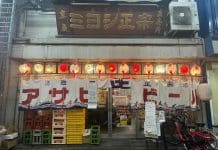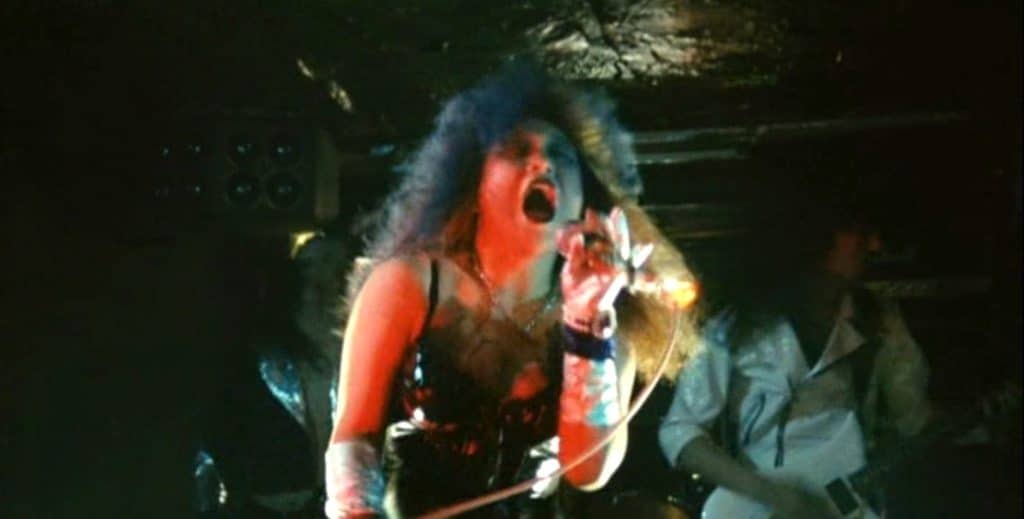
The film opens with shots of wildly dressed and wildly haired 1980s all-female Osaka hard rock band Majoran, performing their signature song We Are Majoran live in a club. The band name and both the song and the film title spell Majoran as魔女卵. Majo (魔女) meaning witch and 卵 (commonly read as tamago) means egg. So, Witch’s Egg is the name of the band and the title of the movie in English.
The Majoran band’s music turns into the soundtrack of large biker gangs cruising through Osaka, seamlessly shifting to images of high school girls on a rampage, beating up a teacher. High school girls roaming the streets of Shinsaibashi, stealing records from the stores, sniffing glue out on the street.
Seamless cut to high schooler Rei (Yuko Watanabe), the main character of the movie entering a coffee shop, meeting with two classmates. Soon, the three girls are out on the street again, exploring Osaka Minami Machi (called Southern Downtown in the subtitles). Minami Machi, that’s the area around Shinsaibashi, Dotonbori and Namba.
They laugh at a sign advertising a “Salarymen’s Turkish Bathhouse” (a sex business), they are picked up by trio of young Tokyo toughs in a rock bar and taken to the harborside for an evening out.
The Tokyo guys are amazing dancers, strutting their stuff to taped music out on the pier. But then, they want more and the girls aren’t ready for it. Things get nasty.
Just in time, a lone motorcycle rider happens to drive by. He quickly realizes what’s going on and steps in, rescuing the girls.
That motorcycle rider is Sabu (Ginji Gao), leader of the South Osaka Union biker gang.
Table of Contents
Majoran (Japan, 1984) 魔女卵
The following night, the three girls attend a concert at Bahama Club in Shinsaibashi. Rei gets in a confrontation with Riri, the leader of the groupie gang. Things threaten to get violent when suddenly Sabu steps out of a backroom. He works at the club and he calms things down.
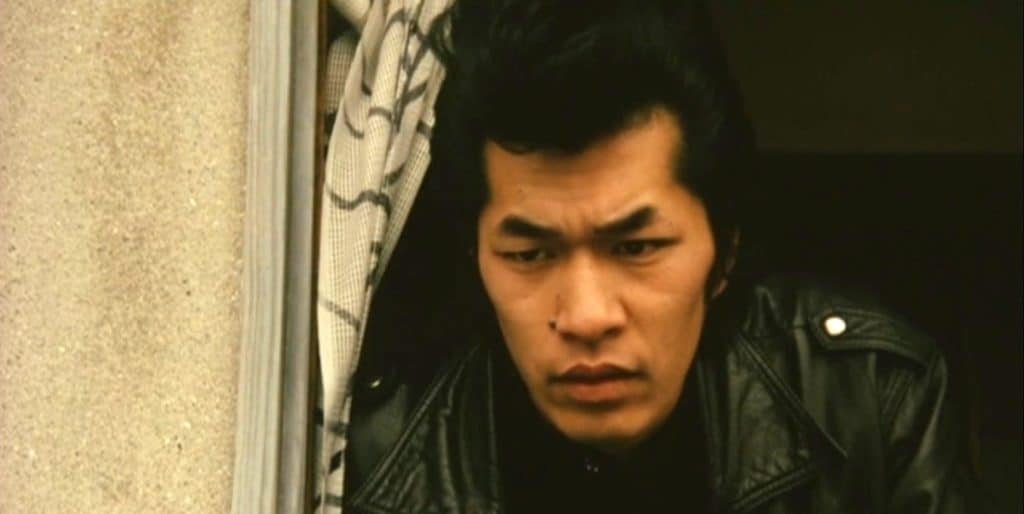
Sabu instantly recognizes Rei and invites her for a bike ride the following day. The two of them set out to somewhere at the floating lumberyards of either Suminoe Ward or Sakai City… very far in the south of Osaka.
The South Osaka Union owns a club house there but, as Sabu explains, they handed it over to a band. Sabu wants Rei to meet the band.
That band is Presence, a real Osaka hair metal band of the 1980s. Rei soon develops sympathies for the band’s guitarist Daisuke (Katsuya Nishioka) though her real interest is Sabu.
Sabu however considers Rei as a sort of young sister he must protect. Sabu encourages both Rei and Daisuke to form a relationship.
Rei runs away from home and moves in with Sabu, her platonic guardian. Listening more to the hard rock of Presence and getting closer to Daisuke, Rei rapidly turns from cool high school girl to hard hitting rock chick.
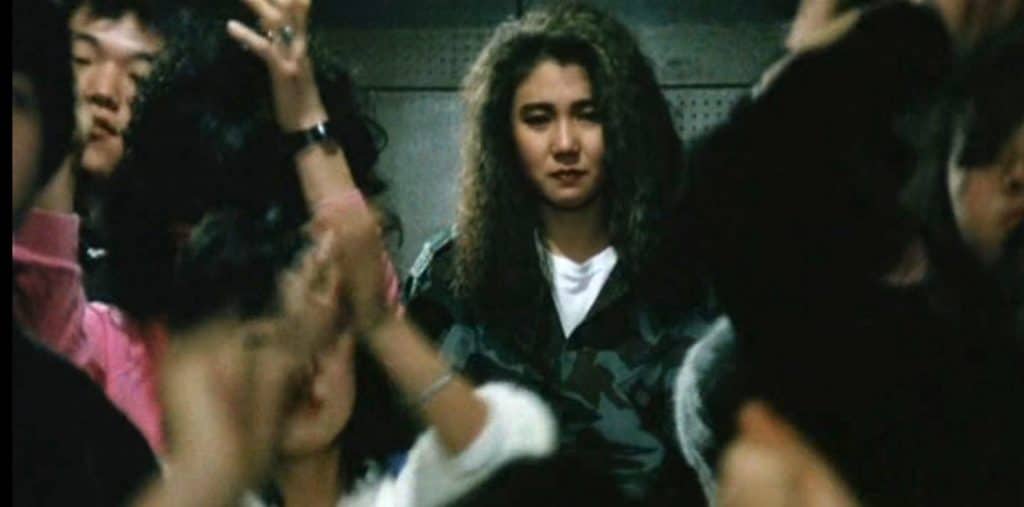
A change that she advertises by a radical new hairstyle: from long straight black she switches to a curly red mop. In the frequent fights with the band’s groupie girls, she now asserts herself as the majoran, the witch’s egg.
She declares to Daisuke that she will take care of the band. She will be the manager, overseeing their upcoming grand music industry audition in Tokyo.
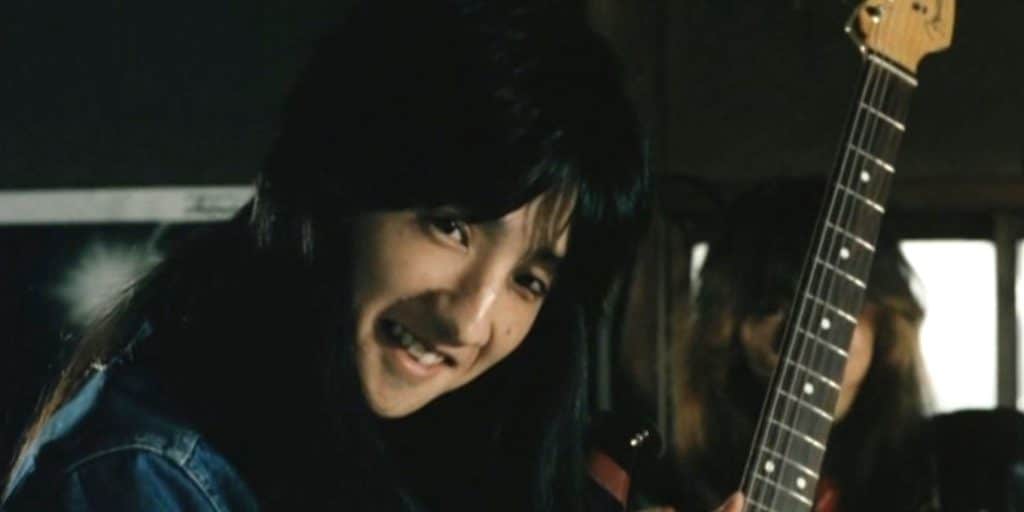
Daisuke’s reaction is rather muted but Rei presses on. She designs new outfits for the band and she raises the money to pay for them all by herself.
Selling and stealing drugs, doing a hilarious stint as a sex worker satisfying a geriatric shrine master out in the countryside, Rei does everything to realize her plans.
She wants to be the ultimate groupie, she wants to be like Nancy Spungen, the Sex Pistols groupie and girlfriend of Sid Vicious. Spungen got stabbed to death in a drug filled night at the Chelsea Hotel in New York in 1978. Murdered by Sid Vicious, the movie insists though the real murderer was more likely a low-level drug dealer / small time actor. In any case, Rei doesn’t know much about rock history. Her talking about wanting to be like Nancy Spungen just means that she is totally dedicated to the band, nothing else.
The hippest rock boutique in town, Rock Za, realizes Rei’s fashion ideas for the band.
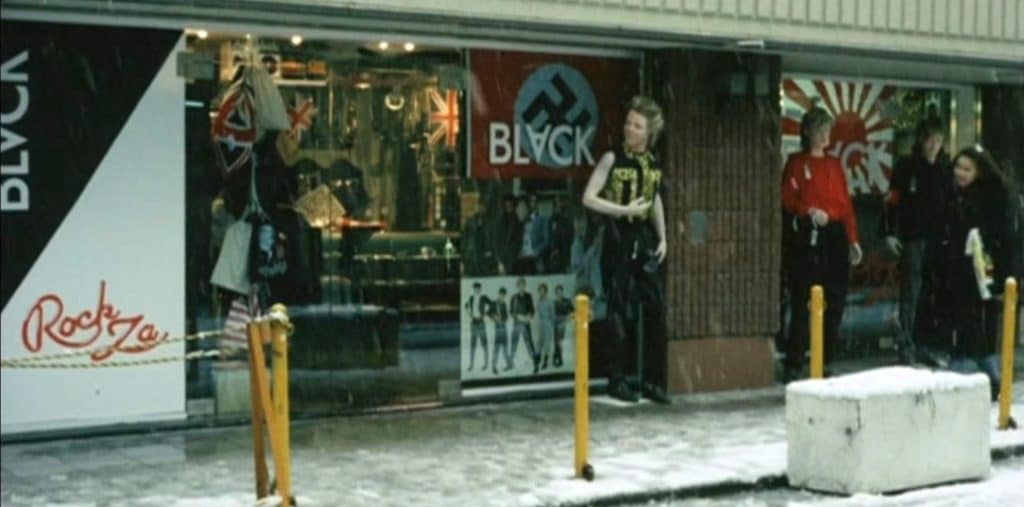
A Swastika flag next to the Union Jack and the Rising Sun flag… that was Osaka rock fashion in the day. Nobody cared about the meaning of any of the flags. They were all just fashion accessories… the swastika flag of course being most closely associated with the iconic T-Shirt Sid Vicious wore on his rampage through Paris in the Great Rock‘n’ Roll Swindle (1980).
Eventually, the Presence band heads to that all-important audition in Tokyo, dressed in Rei’s new outfits. … Daisuke thinks that that audition will be the most important event in his life.
Will the local Osaka band succeed in front of the Tokyo music industry bigwigs? Let’s just say that the movie displays a very defiant, very Kansai attitude towards Tokyo throughout.
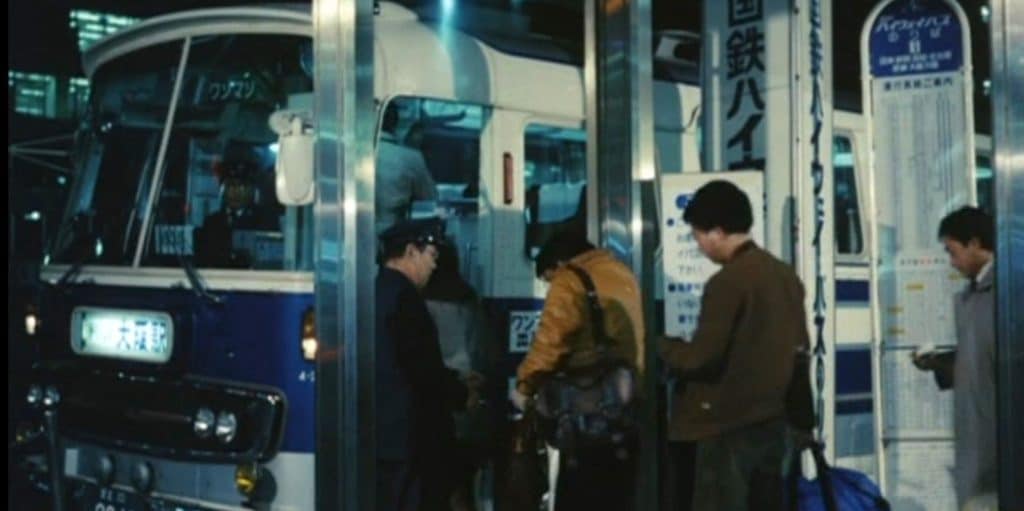
Rei takes the highway bus back to Osaka… with a haunting rendition of Osaka Umareta Onna (Woman Born in Osaka) sung by Ruriko Okami on the soundtrack. The song was a big hit at the time, nationally popularized by male singer Boro. It tells of the sadness a true Osaka woman feels when living elsewhere than her hometown.
The Music
With the exception of Osaka Umareta Onna, all music in the movie is hard rock / hair metal. The Majoran girl band appears only at the very start of the movie and then during of the end credits again.
The all-male Presence band however is seen throughout the film, performing in their rehearsal room and onstage numerous times. They also provide the soundtrack to the nightly motorcycle rides and biker gang confrontations.
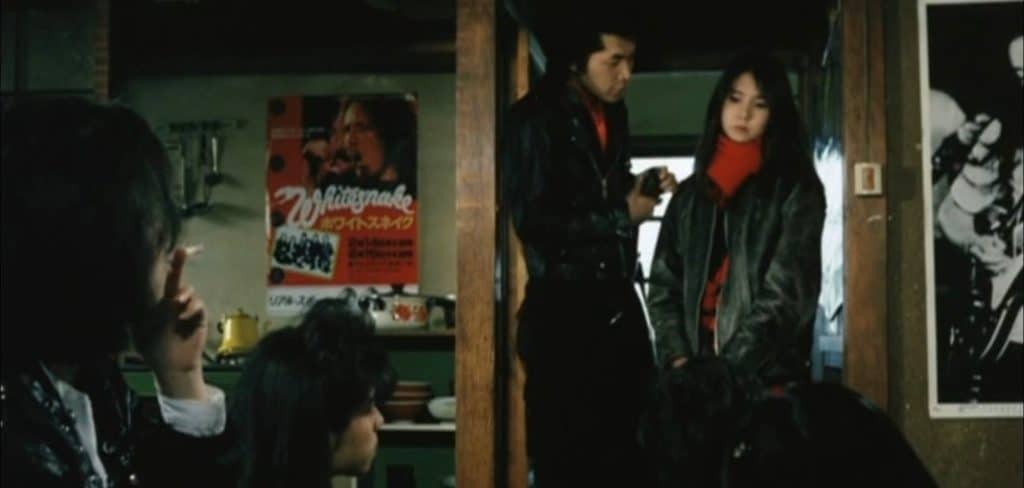
A poster of British hard rock band Whitesnake adorns their rehearsal space. Whitesnake, at the time at the peak of their career, that’s where Presence draws its inspiration from.
Punk is often referenced in the film as a powerful influence but, alas, as a thing of the past. At one point a profusely bleeding punk enters the Bahama club and gets immediate medical attention by Rei. The punk had slashed himself after failing a band audition. “Yeah, punk is over,” the folks at the Bahama agree.
In reality, of course, punk was far from over at the time. Japanese hardcore punk just started out. As did so many other radical music styles including noise and noise-related extreme stage performances.
But the focus of the movie is big hair hard rock and the movie does a great job presenting that part of the music scene.
Gritty Realism
The style of the movie owes much to the punk / biker gang aesthetics first put on screen by Sogo Ishii with his genre-defining Crazy Thunder Road (1980) and Burst City (1982).
Wild, noisy bike cruises through the nightly city; dirty, reckless biker brawls in remote industrial wastelands set to hard-hitting rock. Director Akiyoshi Kimata borrows heavily from Ishii with those scenes.
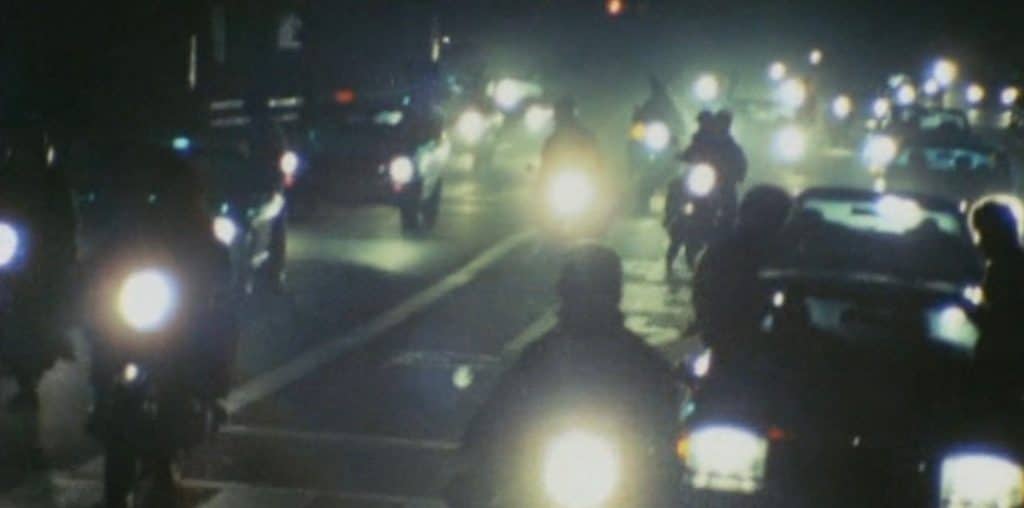
However, gritty realism permeates all of Majoran. Rei has to fight hard to achieve her leading position among the female followers of Presence. Nasty dirty cat fights.
Reportedly, real female juvenile delinquents were recruited to act as female groupie gang members. They brought not only a real tough attitude to the movie but also the toughest of Kansai gang slang. No guy depicted talks as tough as those leather-jacket chicks.
The Director: Akiyoshi Kimata
Director Akiyoshi Kimata, born in Kyoto in 1946, started his career in pink cinema (Japanese sex cinema) in 1972. His father Akitaka Kimata was one of the main producers for Million Films, one of the largest pink movie production companies. He introduced his son to the pink movie business and acted as producer on many of Akiyoshi’s early films.
In pink cinema, Akiyoshi Kimata generally worked under the pseudonym Seiji Izumi.
As Seiji Izumi, Akiyoshi Kimata had shot 49 pink movies by the time he released his first mainstream movie On the Road (1982), a motorcycle cop action flick, for the first time putting his real name into the movie credits.
Kimata continued to working mainly as pink movie director when he filmed Majoran (1984), the second movie he shot using his real name.
The story told in Majoran could have easily involved plenty of sex scenes. However, Kimata refrained from showing anything overtly sexual. The few scenes featuring sex are shot very discreetly, there is (almost) no nudity in the movie.
Kimata is still active as director today, in recent years mostly shooting TV productions.
The Actors
The two main actors, Yuko Watanabe as Rei and Ginji Gao as Sabu both do great, convincing acting jobs. Both were however only active for a brief period in the 1980s, both mainly acting in youth-related films.
Kazuya Nishioka, playing Daisuke, the guitarist of Presence and Rei’s reluctant boyfriend, never acted in any other movie. He may have been a real member of Presence who volunteered for the acting job.
Nishioka’s only other entry in film-related listings is as a composer for a 2012 children’s TV animation series.
Osaka Locations
Majoran is clearly 100% an Osaka film. Heavy Osaka dialect is spoken throughout, Osaka areas (mostly Minami Machi) are mentioned again and again, the biker gangs have names like South Osaka Union and Osaka Giants. There are plenty of street scenes, there is lots of motorcycle riding.
But there are no obvious Osaka landmarks in sight anywhere. There is no Osaka Castle, no Tsutenkaku Tower, no Dotonbori Riverside.
Clearly, the movie takes on the perspective of the young rock fans here. They don’t care about the tourist landmarks, they live their lives their way.

Still, there are a few scenes that clearly show Osaka scenery. One of them being a bike ride south with a Hankai Tramway heading for Hamadera Ekimae in Sakai City, Osaka in clear sight. The tramway traverses much of the deep south of Osaka.
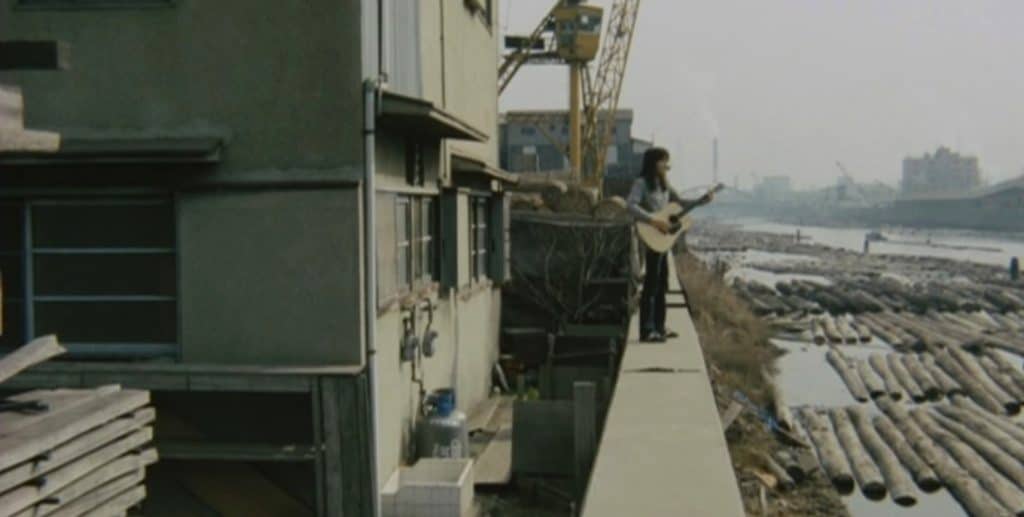
Floating lumberyards were common in Osaka along all the rivers up to the 1950s and beyond. By the 1980s, however, the remaining active yards dealing with floating logs were largely to be found in Suminoe Ward and Sakai City. The movie captured some great shots of those.
The movie credits mention three Osaka rock clubs as shooting locations. One is the Banana Hall in Doyama, Umeda. The club is still active today.
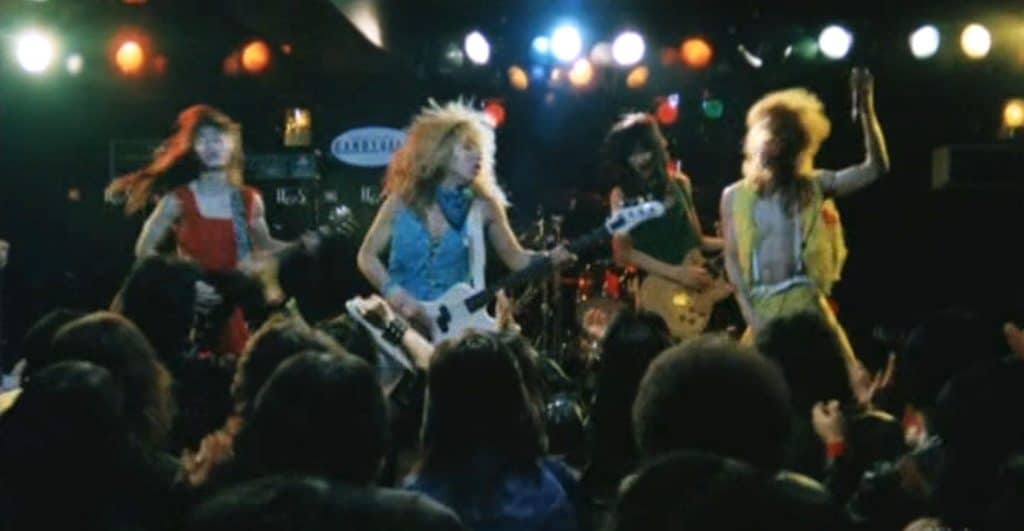
Candy Hall, where Presence has an important concert leading to the audition in Tokyo, was also located in Umeda. Reportedly, Candy Hall had to close in 1994 due to noise complains.
The Bahama Club in Nishi Shinsaibashi serves as one of the central focus points of the movie. The club appears in the movie under its own name, the club is part of the story with a fictionalized owner, frequent brawls and both Sabu and Rei working there. The Bahama Club closed in 2003.








